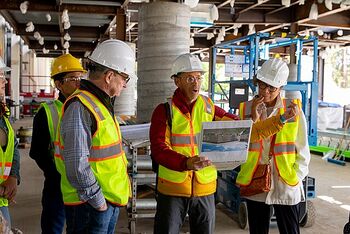Step 1 of Pre-Analysis Communication: Develop Project Understanding and Objectives

|
| Prior to modeling, the dam owner and engineer should meet to discuss the modeling approach.
Source: Wikimedia Commons |
Prior to commencing any modeling effort, an understanding of the model objectives, project constraints, and overall approach should be developed. In order to develop this project understanding, the dam owner and engineer/modeler should meet to discuss the modeling approach, including items that can substantially impact cost and/or schedule. Commonly, the regulator is not involved in early scope of work discussions that have financial or contractual components. Discussion items could include the following:
- A definition of the model’s purpose. To facilitate discussion, this can be organized as a problem statement followed by a justification (i.e., Why is the model needed and what problem is the model trying to solve? What are the potential consequences of not conducting the proposed model?). If the need for the model is driven by a regulatory requirement, how the model addresses such requirement should be discussed.
- Anticipated assumptions and methods required to complete the modeling effort that may impact result accuracy, level of effort, and/or schedule. Key assumptions may include software selection, scenarios, parameter selection, etc. It is beneficial to identify which assumptions are foundational and may require additional communication and concurrence from regulators or other stakeholders. See examples of key assumptions and important considerations for specific model types on these pages: Seepage Analysis, Slope Stability Analysis, Hydrologic Analysis, Hydraulic Analysis, and Consequence Estimation.
- Necessary field data collection efforts to fill data gaps and reduce potential for error and uncertainty in the model. This may include topographic and/or bathymetric survey, geotechnical subsurface explorations, material testing, water quality sampling, etc. An initial parametric study can be helpful in identifying the importance of additional field data.
- Preliminary planning for model validation and/or calibration based on the known available data or lack thereof. The possibility a model may not calibrate or result in significant reduction of uncertainties should be considered, noting that other benefits of the attempted modeling effort may warrant taking this chance. Some application-specific considerations for model validation are also included on these pages: Seepage Analysis, Slope Stability Analysis, Hydrologic Analysis, Hydraulic Analysis, and Consequence Estimation.
- Proposed quality assurance and review plan. This may include an internal review, external review, or regulator review. The intended use and potential complexity of the model should be considered in developing the plan. Associated financial impacts of the selected review also need to be discussed. When the model is to be used for a complex design, to assess the risk of a high consequence facility, as input to other critical analyses, or when other circumstances merit, the regulator may require an external board of consultants or other third-party reviewer. Both the dam owner and modeler would benefit from discussing this possibility prior to developing the scope of work.
- Possible model outcomes. A clear understanding of the intended or unintended outcomes resulting from a modeling effort is beneficial to all involved parties.
- Preferences and expectations for deliverables. This may include formatting of report or technical memorandum, formatting of data files, level of detail, interim deliverables, etc.
- Expected level of effort. Each of the previous discussion items can impact the level of effort. In some cases, it may be beneficial to show how the level of effort may change should the assumptions or validation/calibration plan need to change. Effort for coordination with regulatory agencies also needs to be discussed, including the potential need for a formal model work plan submittal (described in more detail in Step 3). Additionally, the previous bullet points could lead the engineer to need a subcontractor for certain portions of the work. For example, it may be more cost-effective and time-efficient to hire a subconsultant with 3D CFD modeling expertise rather than purchase and learn to use the software in-house.
- Anticipated schedule for the modeling effort. This is particularly important if the schedule may impact project objectives or must comply with regulatory deadlines. The schedule discussion may also include the potential to phase the modeling effort. This may be beneficial when uncertainty is expected to be high or when initial results may influence the approach to future modeling efforts such as scenario selection, analysis method (e.g., 2D versus 3D), etc.
Up Next: Step 2 of Pre-Analysis Communication: Develop Scope of Work
Development of this page was sponsored by the Montana Department of Natural Resources & Conservation with funding from the FEMA Assistance to States Grant Program.
Revision ID: 8005
Revision Date: 06/25/2024
